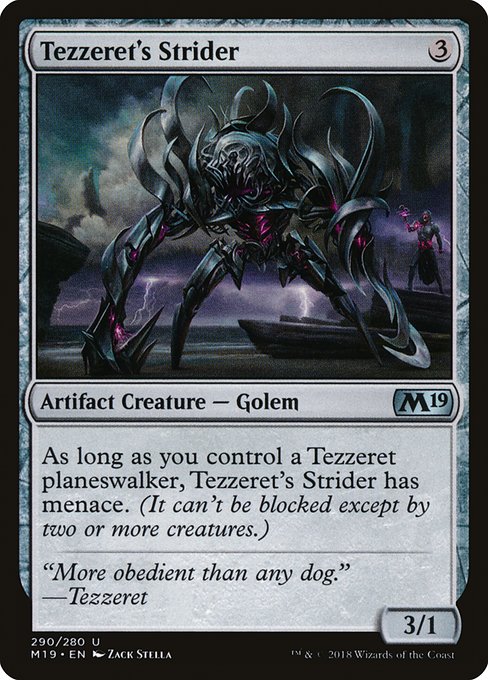
Image courtesy of Scryfall.com
Mulligan Timing for Tezzeret's Strider in Opening Hands
When you crack open Tezzeret's Strider in Core Set 2019, the first decision you face after shuffling is deceptively simple: keep or mulligan? On the surface, a 3-mana artifact creature for 3 power with a clean 1 toughness seems sturdy enough to anchor a midrange plan. But the real payoff comes with the subtle database of Tezzeret synergy. This uncommon artifact creature becomes a menace on the battlefield only if you’ve got a Tezzeret planeswalker staring down your opponent’s board. That conditional power is the heart of mulligan timing—do you have the pieces to unlock Strider’s real threat level, or should you aim for a more deterministic start? 🧙🔥
What Tezzeret's Strider actually does
Tezzeret's Strider is a colorless artifact creature — Golem, with base stats 3/1 and a nuanced twist: As long as you control a Tezzeret planeswalker, this creature has menace. In practical terms, the card sits on the battlefield as a solid early drop that threatens to punch above its weight once the Tezzeret plan arrives. The card’s text invites a very specific mulligan calculus: if your opening hand contains Tezzeret (or a reliable way to deploy Tezzeret early), Strider’s menace can overwhelm slower boards, pressuring planeswalkers and life totals in a way a vanilla 3/1 wouldn’t. The flavor—“More obedient than any dog.”—narratively reinforces the cunning duo you’re aiming to deploy: Tezzeret plus Strider, marching toward a metal-tinged inevitability. ⚔️🎨
Opening-hand evaluation: keep vs. mulligan
With London Mulligan now standard, every mulligan costs you one card of your starting seven. You draw a fresh seven, decide how many cards to put on the bottom, and end with seven minus your mulligans in hand. That rule change makes the decision more nuanced: you’re weighing tempo against consistency, not simply chasing a one-card solution. Here are practical guidelines to consider when Tezzeret's Strider appears in your opening grip:
- Keep when you have a Tezzeret plan backed by mana and draw or ramp. If your hand contains a Tezzeret planeswalker (any version you’re running) and 2–3 lands plus a way to accelerate or fetch Tezzeret, Strider becomes a fast-acting threat. Turn 3 or Turn 4 deployment can threaten a decisive race, especially if your opponent can’t immediately remove the Strider on its own terms. 🧙♂️
- Keep with enough mana sources to hit a turn-3 or turn-4 Tezzeret drop. A hand with Strider plus reliable mana (at least two lands for turn 3, or a mana accelerator) and a cantrip or card draw spell is valuable. The goal is to reach the moment when you have Tezzeret on board and Strider on the battlefield, turning menace into a lead-on pressure. 💎
- Consider a mulligan if there’s no Tezzeret and little ramp. A hand that has Strider but no Tezzeret and only slow or clunky mana sources might stall you into a situation where your 3/1 never becomes a real threat. In such cases, trimming down to 6 or 5 cards can help you hunt for Tezzeret while keeping a credible path to pressure. ⚔️
- Guard against fast disruption in the current metagame. If you’re facing aggressive starts with cheap removal or artifact hate, Strider by itself can be a target before you even flip the switch on Tezzeret. If your opening hand lacks resilience to early removal, you might cycle or mulligan to seek a more robust start. 🧙🔥
- Commander and nontraditional formats tend to value consistency more than raw speed. In EDH or other singleton and multi-player environments, you’ll often benefit from slides of extra card draw, mana acceleration, or alternate win conditions that synergize with Tezzeret’s broader toolbox. The Strider-on-turn-3 vibe is less about single-card tempo and more about turning a board into a metalfication of inevitability. 🎲
How to parse your matchups
Against control or midrange decks that can sweep or out-resource you, you’ll want to buy time with a few cheap threats and a plan to untap with Tezzeret on the battlefield. In these matchups, a mulligan-friendly starting hand that can find Tezzeret quickly becomes the anchor—the Strider simply unlocks menace once your planeswalker arrives. Conversely, against aggro decks, you might favor a more aggressive approach: keep hands that let you deploy Strider on curve and threaten to collapse the board before your opponent can stabilize. The key is to control the tempo: every mulligan decision pushes you closer to that moment of “Strider plus Tezzeret equals inevitability.” 🧙💎
Practical takeaways for your deckbuilding and practice
When you’re building a Tezzeret-centric shell around Tezzeret's Strider, you’re betting on double-activation tempo: you want to drop Strider while ensuring Tezzeret comes down soon enough to flip the switch on menace. Here are a few practical tips to lock in consistent mulligan decisions:
- Include multiple Tezzeret planeswalkers in the deck to increase your odds of opening with a plan to enable Strider’s menace early.
- Stack a mix of mana sources and draw spells that help you locate Tezzeret quickly—think artifact ramp, draw, and tutor-like effects where available.
- Practice opening-hand scenarios in testing sessions to internalize which seven-card starts reliably hit your stride by turns 3–4. The more you repeat, the more you’ll feel confident receiving that classic Strider-on-turn-3 pressure. 🧭
And if you’re gearing up for game-night vibes beyond the table, here’s a small reminder that your gear deserves as much love as your deck. For fans who want a splash of color and durability on the go, a Neon Slim Phone Case for iPhone 16 offers both style and protection on competitive weekends or casual play sessions. It’s the sort of practical upgrade that doesn’t shout “tournament armor” but quietly supports your focus and comfort. 🎨